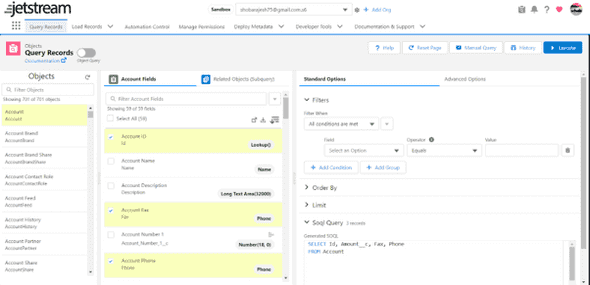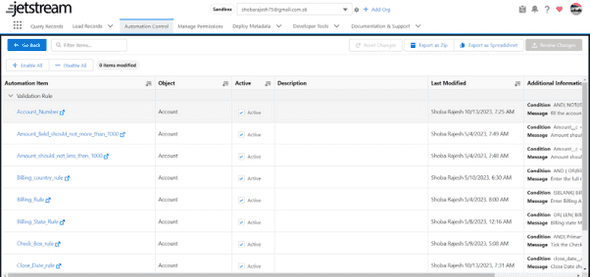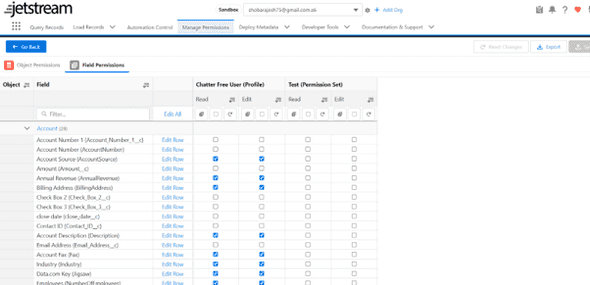It is used to connect as many Salesforce Orgs as we want, providing a fast and secure way to switch between orgs. It can move and compare metadata between orgs, manage field level security in bulk.
Jetstream is source - Available and free to use
It has the most advanced query builder ( Query Records) and it helps us to explore the data model and find the records we are looking for.
Based on the objects and field selected, it queries automatically. We have a manual query Option available. We can query using the standard options and advanced options available in it.
Query Builder is not only used for viewing record data, but it is also used to view objects and fields along with a ton of useful information like field API names, picklist values, field dependencies and more.
****************
If we want to make changes in our record data, we can use the simple and powerful Data Loader( Load Records) without any usage limits. We can even load related data to multiple objects at the same time. We can avoid using complicated VLOOKUPS in Excel to load related data into salesforce.
We can Insert,Update,Upsert and delta multiple records with a single shot.
**********************
To review and toggle automation in our org we have an Automation Control feature available. We can use this to temporarily disable automation prior to a data load.
It supports the following automation.
Apex Triggers(This is not supported in production orgs because of salesforce code coverage requirements)
Validation Rules
Workflow Rules
Record Triggered Flows
Process Builders.
We can choose as many objects as we would like and choose the type of automation that we would like to view. After the page loads, we can see a list of all the metadata items in a table and we can easily toggle which ones are active.
When we are ready to deploy the changes, using the Review Changes we can get a summary of all changes .
******************
Permission Manager feature in Jetstream makes it easy to view and modify object and field level security across many profiles and permission sets for multiple objects
We can toggle the object permissions by clicking on the Object Permissions tab. If we make any change, a number will appear in the tab bar indicating the number of modified items.
We can change the permission for all individual items and also we can change permission for all fields for one profile or permission set.
********************
Deploy Metadata feature provides the ability to work with metadata in our org and it includes the following items.
- Deploy metadata from one org to another org
- Add metadata to an outbound changeset
- View the contents of metadata
- Compare metadata between two orgs.
- Delete metadata from an org
- Download a metadata package
- Deploy a metadata package.
It allows us to load in Custom Metadata records using a csv or xlsx file just like loading to any other type of object.
For custom Metadata records, the Metadata API is used to load in data. We can view these on the Deployment status page
**********************
Developer tools available in the jetstream can replace Developer Console. Because we can easily execute anonymous Apex, view debug logs from our orgs, submit API requests using the Salesforce API and subscribe to and publish Platform Events.





Leave a Comment